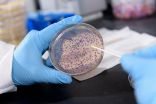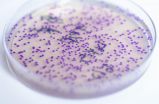(Press-News.org) A bacterium engineered to produce different pigments in response to varying levels of a micronutrient in blood samples could give health officials an inexpensive way to detect nutritional deficiencies in resource-limited areas of the world. This "bacterial litmus test," which currently measures levels of zinc, would require no electrical equipment and make results visible as simple color changes.
More than a billion people worldwide may be at risk for adequate zinc intake, but measuring zinc levels in blood samples currently requires sophisticated testing equipment not available in many affected areas. If field tests show the biosensor can successfully measure zinc levels, the researchers hope to extend the concept to other micronutrients, including vitamins.
"We think this is just enough technology to meet the needs," said Mark Styczynski, an assistant professor in the School of Chemical & Biomolecular Engineering at the Georgia Institute of Technology. "The information we can provide could one day help nutritional epidemiologists and non-governmental organizations determine the populations of people that may need interventions to address nutritional deficiencies."
The proof-of-concept work was reported in the September issue of the journal Metabolic Engineering. The research was supported by the Bill and Melinda Gates Foundation, the National Science Foundation and the National Institutes of Health.
The biosensor is based on modified Escherichia coli (E. coli), a bacterium that is frequently used in genetic engineering. E. coli has a transcriptional system that responds to the level of zinc in its environment, and the researchers have tuned it to trigger the production of purple, red and orange pigments. Genetic machinery for the production of those pigments was taken from other biological sources and introduced into the E. coli.
In practice, health professionals in the field would obtain blood samples from persons suspected of having a zinc deficiency. The blood samples would be spun on a simple mechanical device resembling an eggbeater to separate the plasma from the blood cells. The plasma would then be placed into a test tube or other container with a pellet containing the modified E. coli.
Once mixed with the plasma, the E. coli would multiply, producing the color corresponding to the level of zinc in the blood plasma. Purple would correspond to dangerously low levels, while red would indicate borderline levels, and orange normal levels. The color would be readily visible without any diagnostic or other electronic equipment.
"The process for the color change would take about 24 hours from when the plasma sample is added, though we are hoping to accelerate that," said Styczynski.
The testing wouldn't be done to identify individuals in need of treatment, but would be used to assess the nutritional needs of a larger population of people.
"Places where you are likely to encounter micronutrient deficiencies will typically be resource-poor countries, or perhaps locations suffering natural disasters," Styczynski explained. "These deficiencies aren't treated on an individual level, but are considered on a population level and used to treat a village or a region that may be affected. We could take samples from 50 or 100 people and be able to assess the nutritional status of an area."
Because bacteria don't have the same requirements for many vitamins relevant to human health, the researchers may have to change organisms when they develop tests for other micronutrients, like Vitamin A. Those tests will likely use a yeast organism which has also been extensively studied and into which sensing and pigment-producing genetic machinery can be introduced.
"Ultimately, we hope to be able to test for a whole suite of nutrients in a reasonably short period of time and at a relatively low cost because no equipment would be needed in the field," Styczynski added.
As part of their research, Styczynski and graduate research assistants Daniel Watstein and Monica McNerney engineered pigment producing machinery into the E. coli. The red and orange colors, lycopene and beta-carotene, are produced by genes taken from Pantoea anantis, a plant pathogen. The purple color, violacein, came from a soil bacterium. Genes for producing the pigments were placed onto a plasmid and introduced into the bacterium.
The researchers used two zinc-sensing proteins within the E. coli and controlled the extent to which those proteins could turn the pigment producing genes on and off. This approach made the zinc-sensing proteins responsive to levels of zinc close to that expected to be found in blood plasma, and can be further used to allow them to turn on at arbitrary levels.
One of the challenges was to avoid producing amounts of pigment that might be toxic to the bacterium, while producing pigment quickly enough to be visible to the naked eye. And because the orange and red pigments are generated in the same metabolic pathway, the researchers needed to establish ways to produce only one or the other at a time - a challenge that their work shows can be feasibly addressed, though they are still working to fine-tune the implementation.
Styczynski believes this system is the first designed to measure blood micronutrients using bacteria without requiring diagnostic equipment. Other techniques have required specialized measurement equipment that is difficult to transport and maintain in the field.
"The general idea of bio-sensing is certainly out there, but we have taken the step of developing a system that doesn't require equipment in the field," he said. "We believe this will work well in low-resource areas."
Among the next steps are development of techniques to freeze-dry the bacterium, and an assessment of the potential ecological impact of the modified bacterium. Styczynski hopes field trials can begin within the next two years.
"This is a convincing proof-of-principle, and we hope to begin the translational aspects of this system based on what we have already shown," he added. "It's a matter now of reducing this to practice for something that will ultimately be useful."
INFORMATION:
This research was supported by the Bill & Melinda Gates Foundation under grant OPP1046289, the National Science Foundation under grant 1254382, and a National Institutes of Health training grant T32-EB006343. The content of this news release is the responsibility of the authors and does not necessarily represent the official views of the supporting agencies.
In the "NeverEnding Story", Bastian feels so involved in the narration that he experiences the same emotions as the characters (and in the end he really enters the book). What happens to the main character of Micheal Ende's book is exactly what happens to each of us when we read a novel or a short story: we literally replicate the physiological processes and emotions of the characters described in the text. Francesco Foroni, research scientist at the International School for Advanced Studies (SISSA) of Trieste, already demonstrated this phenomenon a few years ago in a study ...
PULLMAN, Wash.--Washington State University researchers have found that the timing of an animal's sleep can be just as important as how much sleeps it gets.
Ilia Karatsoreos, an assistant professor in WSU's Department of Integrative Physiology and Neuroscience, shifted mice from their usual cycle of sleeping and waking and saw that, while they got enough sleep, it was of poorer quality. The animals also had a disrupted immune response, leaving them more open to illness.
Most sleep research focuses on the effects of sleep deprivation or the overall amount of sleep an animal ...
A multi-disciplinary group of European researchers spanning natural science, socio-economics and law have joined forces to assess the current landscape of deep-sea research and investment in Europe. Once considered remote and inaccessible, commercial interest to exploit the deep sea (1) is rising due to economic drivers and technology developments. However, exploitation activities in the deep sea remain highly contentious, particularly regarding the potential risks and environmental impacts associated with such activities. A consultation of deep-sea stakeholders spanning ...
New research from LSTM has revealed precisely how insecticide-treated bed nets are so effective against malaria mosquitoes.
Communities in the poorest countries are the most vulnerable to malaria and 90% of all malaria deaths occur in Africa. Safe, simple and affordable, long-lasting insecticidal bed nets (LLINs) are very effective in preventing malaria and have played a major part in reducing malaria deaths in Africa by over 50% since 2000 (WHO). However, as very little is known about how mosquitoes interact with nets or how LLINs do their job so effectively, how they ...
Researchers at University of La Rioja (Spain) have developed a new method to eliminate artificial satellites in Highly Elliptical Orbits when they finish their mission. The methodology, which allows for a reduction of both cost and risk, has been tested with the European Space Agency INTEGRAL mission, which will re-enter into the Earth's atmosphere in order to disintegrate in 2029.
The problem of space debris is one of the main challenges that aerospace engineers have to face, due to the danger it poses to satellites. In this context, members of the Scientific Computing ...
BEIJING, CHINA (1 September 2015)--At a time when the price of mutton is climbing and wool crashing, a groundbreaking new study has used advanced genetic sequencing technology to rewrite the history of sheep breeding and trading along the ancient Silk Road--insights that can help contemporary herders in developing countries preserve or recover valuable traits crucial to their food and economic security.
The new findings regarding one of the first animals ever domesticated will be published in the October print edition of the journal Molecular Biology and Evolution. They ...
DENVER (Sept. 1, 2015) - While many planners focus on the threat of natural disasters to major metropolises around the world, a new study from the University of Colorado Denver shows smaller cities are often even less equipped to handle such catastrophes.
"Small cities are often far away from where decisions get made and struggle to insert themselves into the agenda of decision-making bodies," said study author Andrew Rumbach, PhD, an assistant professor at the CU Denver College of Architecture and Planning, a major center of timely, topical and relevant research. "When ...
The unique properties found in the stunning iridescent wings of a tropical blue butterfly could hold the key to developing new highly selective gas detection sensors.
Pioneering new research by a team of international scientists, including researchers from the University of Exeter, has replicated the surface chemistry found in the iridescent scales of the Morpho butterfly to create an innovative gas sensor.
The ground-breaking findings could help inspire new designs for sensors that could be used in a range of sectors, including medical diagnostics, industry, and the ...
A team of researchers led by scientists at the National Geospatial-Intelligence Agency published a new map Sept. 1 that characterizes the Earth's radioactivity and offers new and potential future applications for basic science research and nonproliferation efforts.
The Antineutrino Global Map 2015, or AGM2015, is an unprecedented experimentally-informed model of the Earth's natural and manmade antineutrino flux.
The map uses open-source geophysical data sets and publicly available international antineutrino detection observational data to depict varying levels of radioactivity ...
London, UK - 1 Sept 2015: Most patients with a cardiac resynchronisation therapy (CRT) pacemaker would not benefit from the addition of a defibrillator, according to results from the CeRtiTuDe cohort study presented for the first time today at ESC Congress1 and published in European Heart Journal.2
"The choice between CRT with (CRT-D) or without (CRT-P) a defibrillator remains a contentious issue," said Professor Jean-Yves Le Heuzey, cardiologist at Georges Pompidou Hospital, René Descartes University in Paris, France. "No randomised clinical trial has been conducted ...



